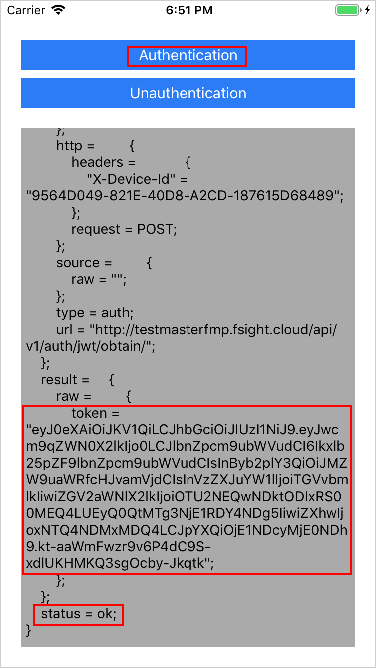
To execute authentication on a mobile platform server, create the HHFWAuth application, which uses framework methods:
| Method name | Brief description |
| initWithCredentials (_: host: environment: project: device:) | The method initializes the framework. |
| auth (_: password:) | The method authenticates the user by login and password. |
| unAuth () | The method cancels user authentication. |
The HHFWAuth application includes one screen, the UITextView text view, and UIButton buttons:
«Authentication». Execute authentication
«Unauthentication». Cancel authentication.
NOTE. When the application is initialized, only the Authentication button is available.
To execute the example:
Click the Authentication button.
Clicking the button requests to execute authentication from a mobile platform server. If the authentication is successful, a token is returned.
The Authentication button is not available, and the Unauthentication button is available.

Click the Unauthentication button.
As a result, the authentication will be canceled. The Unauthentication button is not available, and the Authentication button is available.
Application code:
import UIKit
class ViewController: UIViewController {
// Determine output variables
@IBOutlet weak var resultTextView: UITextView!
@IBOutlet weak var authButton: UIButton!
@IBOutlet weak var unAuthButton: UIButton!
// Redetermine method
override func viewDidLoad() {
super.viewDidLoad()
self.activateAuth()
self.initializeFramework()
}
// Set method that will be executed on button click
@IBAction func authPressed(_ sender: UIButton) {
self.auth() { (jsonResult) in
self.activateUnAuth()
self.resultTextView.text = String(format: "%@", jsonResult)
}
}
@IBAction func unAuthPressed(_ sender: UIButton) {
self.unAuth()
self.activateAuth()
self.resultTextView.text = "Unauth success"
}
// Initialize framework
private func initializeFramework() {
let apiVersion: String = "v1"
let host: String = "http://testmasterfmp.fsight.cloud/"
let environment: String = "Leonid_environment"
let project: String = "Leonid_project"
let device: String = (UIDevice.current.identifierForVendor?.uuidString)!
HHFWController.sharedInstance().initWithCredentials(
apiVersion,
host: host,
environment: environment,
project: project,
device: device
)
}
// Authenticate
private func auth(completion: @escaping (NSDictionary)->()) {
let username: String = "test"
let password: String = "test123"
HHFWController.sharedInstance().auth(username, password: password){ (jsonResult) in
if let jsonDict = jsonResult as? NSDictionary,
let status = jsonDict["status"] as? String, status == "ok" {
print("Auth success")
completion(jsonDict)
} else {
print("Auth error")
}
}
}
private func unAuth() {
HHFWController.sharedInstance().unAuth()
}
// Set methods to display application user interface elements
private func activateUnAuth() {
self.authButton.isEnabled = false
self.unAuthButton.isEnabled = true
}
private func activateAuth() {
self.authButton.isEnabled = true
self.unAuthButton.isEnabled = false
}
}
See. also:
Examples of User Authentication on Mobile Platform Server | User Authentication with Password Change